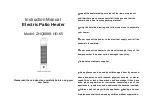
1.0
Circulation heaters for liquid service are designed for
operation only while completely full with liquids. Never allow the
heating elements to be exposed while energized or failure will
result.
Use the heater only in liquids and at pressures
for which it was designed (unless specifically
designed for non-liquid applications). Normally
copper sheath is recommended in water; steel
or alloy sheath in oil; and the appropriate alloy
sheath for heating gas and chemical solutions.
Check factory for recommendations.
2.0
Circulation heaters are welded pressure vessels with inlet
and outlet connections to allow fluid/gas flow and heat transfer
to a customer fluid.
3.0
Where gasket is required, user must ensure that gasket
surface is clean and dry before installing heater.
DO NOT insulate over the heater flange, stilted area
and terminal enclosure.
4.0
The terminals must be protected at all times from moisture
or vapour. In hazardous locations, explosion-proof terminal
housings must be used. In outdoor locations, moisture resistant
housings are required. It is recommended to use a drip loop to
prevent moisture from entering the terminal box via the wire.
5.0
Protect terminals of heating elements from drippings,
condensation, fumes, spray or any other substance which could
result in element contamination.
ISO 9001
ELECTRIC SHOCK HAZARD. All electric heating equipment installations must be performed
by qualified personnel in accordance with the local electrical codes and standards and must
be effectively grounded to eliminate shock hazard.
FIRE/EXPLOSION HAZARD. Do not exceed the ratings of the flange as listed in ANSI B16.5. Do not
operate the heater in the presence of combustible gases, vapours, dusts or fibres unless the heater is
specifically marked for the hazardous location and heater operating temperature does not exceed the
temperature code rating. Corrosion of the sheath could result in a ground fault which, depending upon
the fluid being heated, could cause a fire or an explosion.
FIRE HAZARD. If a thermostat is provided, it is designed for temperature control service only. Since the
thermostat does not fail safe, it should not be used for temperature limiting duty. Wiring to this device is
the users responsibility.
Heaters are capable of developing high temperatures, therefore extreme care should be taken to:
a) use explosion-proof terminal enclosures in hazardous locations;
b) maintain distance between heater and combustible materials.
DESCRIPTION
Heaters with over temperature devices require
specific installation orientation.
ELECTRIC SHOCK HAZARD. Disconnect all power
before installing or servicing the heater. Failure to
do so could result in personal injury and/or property
damage. All maintenance and installation should
be done by qualified personnel in compliance with
local codes.
FIRE OR SHOCK HAZARD: Moisture accumulation
on the dielectric material of the elements sheath,
corrosion or overtemperature on the heaters could
cause a fault to ground generating arcing and molten
metal. Install proper ground fault protection to
prevent personal injury or property damage.
Heaters are electrical components, designers
are responsible for the proper integration to the
electrical systems, including controls and backup
safety devices.
6.0
Provide adequate space for vertical or horizontal installation.
With horizontal mounting, inlet and outlet must be directed
upwards at 90° from the horizontal.
7.0
Ensure that the circulation heater vessel is properly mounted
on a solid steel or concrete base. For heater removal and
maintenance purposes, user must allow sufficient clearance in
the surrounding area of the circulation heater.
INSTALLATION
INSTALLATION, OPERATION AND MAINTENANCE INSTRUCTIONS FOR
TYPE EX – CIRCULATION HEATERS
Email: [email protected]
www.ccithermal.com
Date of Issue: May 2013
Part No. MI416 Rev.10.01
Printed in Canada


























